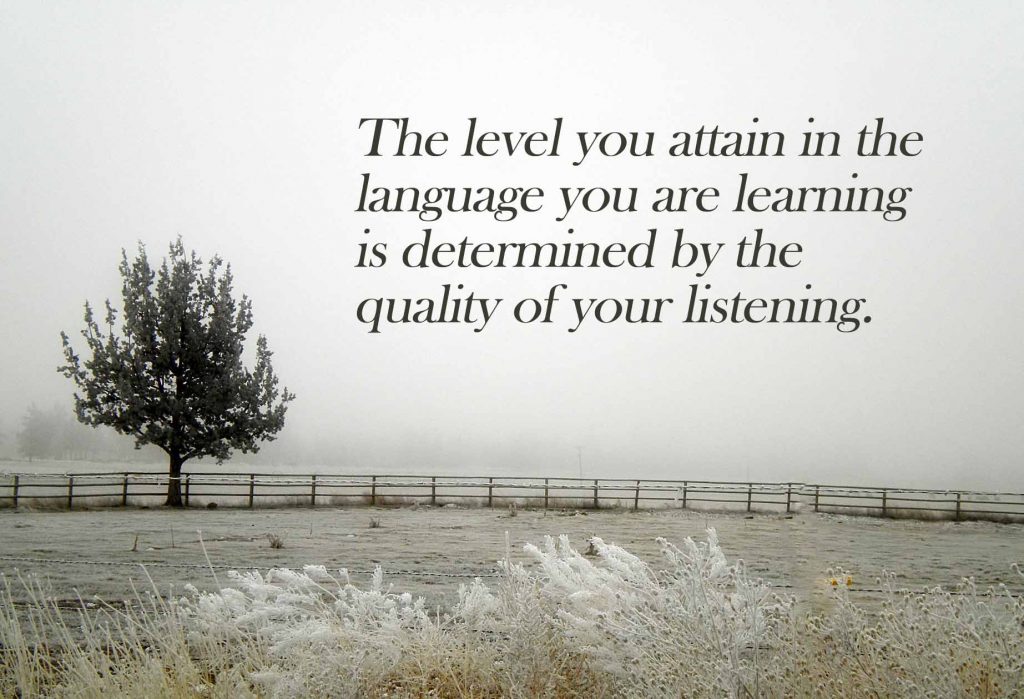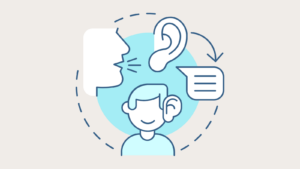Teaching Listening Skills is the Heart of Our Work
Listening is one of the most important skills used in learning languages, and is also one of the least understood. Listening is certainly regarded in the field as being important. However its pivotal importance is not recognised. If it were, a lot more would be done about it. Instead, all the attention is given to aspects of language such as grammar, vocabulary and even pronunciation in ways that don’t recognise listening as having preeminent importance.Teaching Listening Skills is the Heart of Our Work
Listening and looking
Even though listening is a skill in its own right, it is difficult to talk about listening in most situations without also including “looking”. No one talks about learning languages through looking. But without looking to see what has happened as a result of what is said or what happens when others speak, it is very difficult to learn another language. The fact that so little attention has been placed on these skills further tells us how little practical understanding there is.
Perceptual skills
Listening and looking are key parts of what we could call perceptual skills. Maybe perception is talked about so little about in the area of learning languages because of the singular focus on the teaching process. It is important to understand the actual process of learning, or otherwise the teaching we do is easily misdirected.
The perceptual skills are a key part of how we learn our first language and, in fact, learn most of any subsequent languages. Formal language instruction or learning can never hope to cover all we need to know to become proficient in a second language.
A large part of using another language is learned through what we see, hear, and say. While our minds are obviously important, it is through these perceptual skills that we gather the data for our mind to work upon.
Use of Teaching Listening Skills
Learners need to do a lot more than just be taught or exposed to some of the language. They in fact have to make the language their own. A critical aspect to this is the use of listening skills. They are used in a variety of ways, such as:
- to hear what others are saying
- to hear the tone of voice and contextual meaning, such as agenda, bias, sarcasm, etc
- to hear and correct our own mistakes
- to confirm that what we hear ourselves say is/is not in fact what other people use.
It is our own feedback that enables us to adjust or leave alone what we are saying and identify when we need to correct ourselves. It is this self awareness in the auditory field and the subsequent self control which enables us to refine what we do and eventually claim ownership of the new language.
Coming to crippling conclusions
All this is an integral part of continuous improvement. Without learners appreciating the critical role of listening, they can overlook it and come to misleading and possibly even crippling conclusions such as:
- They are not studying hard enough
- Their memory is not good enough
- They didn’t understand what they learned
- They have no talent for learning languages
Apart from all the complexities and nuances of the language that can never all be taught, there is of course the non-verbal communication. This is a key part of communication, and is argued by some to convey more meaning than the words themselves. Non-verbal communication can only be learned by listening and looking.
How meaning is conveyed
When we listen to someone, we extract some of the meaning from the environment in which the language occurs. This meaning is conveyed via many forms, including from:
- the actual context, environment (for example, with colleagues over a lunch break, with colleagues at a meeting, with colleagues at a party, with colleagues whilst other students are present, etc )
- what preceded the language that is spoken
- how the language is said in terms of affective overlay
- the tone, the inflexions and the stresses used in the language
- the use of the hands, eyes and body
- what happens after the utterance.
Without paying attention to all this and more the language and its subtleties will never be fully mastered.
So many students struggle to learn a language, as they are not putting their energy on high yield activities such as listening and looking but instead on low yield activities such as translating and studying. These latter activities of course have their uses but their use needs to be judicious.
Why Listening Skills Can Degrade
We start off with great listening skills in our early years but they often degrade over time. This can happen for a number of reasons. An important one is to do with affective factors, rooted in the development of our upbringing and how we respond to that.
Understanding these factors may be important for us as individuals. If you are wondering how you or your students fare here, cast your eye down the two lists I have provided in the section below.
Another critical factor is our education. There is such a strong assumption embedded in much of formal instruction that we learn by studying, reading and following the instructions of the teacher. Apart from having to listen to the teacher, listening is devalued as a means to learning.
Watching how things work
What I mean by this is that there is a vast difference between being “lectured” about a topic and learning something from listening, deducing, intuiting and watching how “things” work and are done. With the latter, one is learning to build one’s skills and know how, not just adding to a store of knowledge.
There is, I believe, a hidden assumption throughout much of education that people learn best when things are described or explained to them. We actually cripple our students by teaching them not to rely upon their own skills to figure out the problems they face (as we do in real life!). So instead of providing them with structured and engaging “problems” to solve, they are provided with what they need to learn. This I believe serves to undermine the incomparable learning powers to which we all have access.
Placing the focus on really teaching listening skills
This approach in teaching transfers to how learners believe they need to learn of languages. The emphasis too much of the time is on studying the rules, drilling spelling, memorising the sounds and phrases and translating vocabulary. Instead of placing the focus on how listening and looking, along with speaking, can be used to learn grammar and vocabulary.
Listening and Personality
I am sure all of you have come across people who are good listeners, some really good, and many bad. Our listening ability suffers when we put more attention on matters others other than what we are hearing.
There are various reasons why there are many listeners who are more involved with matters outside of what they are listening to. Here are some of the behaviours that can alert you to people who fit this category. They
- pre-empt what you are going to say
- have their own agenda
- latch on to one thing you say and lose the rest
- are preoccupied with their own concerns
- are overly stressed
- are judgemental
- are easily distracted
- are overly critical
- listen for what supports their beliefs.
Listeners who are actually listening well, on the other hand
- don’t do the kinds of things just referred to
(go through the list above and put “don’t/aren’t” before each point above) - are open to new ideas
- seek to clarify what they don’t understand
- seek to put themselves in the shoes of the person talking
- ask open ended questions
- add to the discussion at an appropriate time
- learn from whatever they are listening to.
These factors affect every one but language learners even more.. This is because the demands on listening are far more extensive than just listening to meaning. There is a need to listen for pronunciation, tone, rhythm, language use, and structure all at the same time. Not noticing elements of the new language we are listening to because we are too preoccupied with something else will affect our progress.
We are talking here about achieving a level of listening that typically we have no need of when we are speaking our mother tongue. Some people, typically those who already listen well, come to this more easily. Whilst for others the journey may not be direct, especially if in the classes they do not teach listening skills extensively.
Really teaching listening skills
There is, I believe, a disservice done to our students when we “spoon feed” them with exercises that don’t draw on the senses that we have all been gifted with. Intellectually understanding a grammar point is all well and good. However, do we want to cripple our students by explaining things they can work out for themselves or by giving them one dimensional exercises?
I am not saying here to let them figure it out in some ad hoc way. I am talking about providing carefully crafted situations from which they can extract the meaning and work, with minimal guidance, and put the appropriate language to it. Everyone can learn better by becoming more attentive to their receptive skills. From what they hear and see, their intellect can naturally come into play.
Our role as teachers
Once we reflect on our experience, we understand that we continually extract meaning and sense from whatever we are involved in. This is something that makes us human. All learners are capable of coming to the realisations that underpin how a language is constructed and held together. Our role as teachers is to present situations where they can come to these much faster than they would if they were doing this through just immersion. We can order and group these experiences and watch with amazement how much and how fast learners can pick up new elements of language and use them, once they are fully focussed on listening, looking, and learning from their experiences, speaking out as they are learning.
Here’s the trick
The trick is to design situations whereby learners can work out how the language works. Once they have worked it out for themselves, then some meta discussion may prove useful. Listening and looking are key skills which learners need to exercise, then they can figure out what they need to work on.
Classes came about as a way to systematise the learning and to make it more efficient. How well it has done that is a discussion for another time. What is clear is that what we do in classes can:
- help learners to recapture and develop powerful language learning strategies which they can use in classes and in their life once they have left classes
or it can
- not serve learners by providing the kinds of instruction that reinforce the beliefs that languages need to be learned by:
- studying
- following the instructions of teachers and course books
- analysing grammar
- doing exercises on sheets of paper
- repetition and drilling
none of which has much application once they leave classes.
If there is no awareness of the need to move your listening to new levels and have never been taught to do this in class(as is mostly the case) then it is no surprise why so many people struggle learning languages.
How change can happen
Have you ever tried to “move” a person from being a “bad” listener to a “good” listener? It is not so straightforward as asking them to do a few exercises from a book, or teaching them some grammar. The reality is that the only way this shift is going to happen is if the person recognises the need to embrace it. This can happen for many reasons. In a class the main reason is because we design our lessons in ways that they will “really need to and hence want to” listen. This way they are the ones to focus more, to apply themselves more, not because we have told them to do it, but because they want to and see the need to do it.
So if we accept the fundamental importance of teaching listening skills in classes, a key issue becomes how to get students to want to focus more on listening. This is a very fertile area for discussion.
This can be done in many ways, however at the heart of it we need to:
- Pique and maintain their curiosity
- Have topics that relate to who they are. (Discussing how to bring up children will not go down that well with most teenagers, however discussing what can make us happy relates well to most people)
- Provide tasks that are achievable, not too far outside of what they already can “do”
- Respect their abilities and recognise that everyone can become a good listener if that is what they want
- Avoid giving them exercises that don’t engage them.
If you are keen to improve your teaching, I believe you can’t do much better than learn to become an adept listener yourself. By better understanding how you can improve your listening in all walks of life, including in the learning of new languages and teaching listening skills, you can bring a new energy to your classes built on your growing skills.




4 Responses
Aziz Soubai
I pretty much agree with you on the fact that listening is the heart of learning languages. And to back up that statement, I would say that in language theories and acquistion there is a concept called immersion where the learner need to surround himslef with language and get exposed to language especially through listening! The thing here is this skill is disregarded in our classrooms and the question remains why? Thanks for this great article dear Andrew!
29/05/2016
Andrew Weiler
One reason I believe it is badly neglected Aziz is because there is such a stubborn focus on the study/memorize paradigm. Stale listening exercises do next to nothing for real listening skills, the kind we need to use when we are learning a language. The one we need requires full engagement. Until there is a better exploration and understanding of what is meant by getting "all of us" engaged, I fear that listening will remain a poor cousin.
29/05/2016
Aziz Soubai
Exactly and that sudy/memorize pattern creates nervousness in the class and in that way students retention and motivation hits rock bottom.I do acknowledge that I myself as a teacher do not use a lot of listening activities, but I'm willing to change that and expose my learners to as much real language as possible especially through songs, movies and cartoons. All these relaxing elements if planned in a right way make students fully engaged in the learning process.
30/05/2016
Andrew Weiler
You are spot on Aziz, there is nothing quite like listening to engage learners. There are however many elements to listening, apart from just providing listening activities. I will mention 3 practical ideas here. One is to expect students to listen to each other, so I always avoid students sitting in rows. Sitting in rows militates against listening to each other. Another, building on the previous, is have discussions where each learner is encouraged to contribute to what came before. Students who don't do that are put on the spot, in a humorous manner if possible. The third is creating a space and atmosphere where students feel empowered to ask questions. I do this by asking open ended questions about what has been done in class and again putting them on the spot...so they learn that listening to what is going on and speaking is critical to participating and learning [and dealing with me! ;-)].
31/05/2016